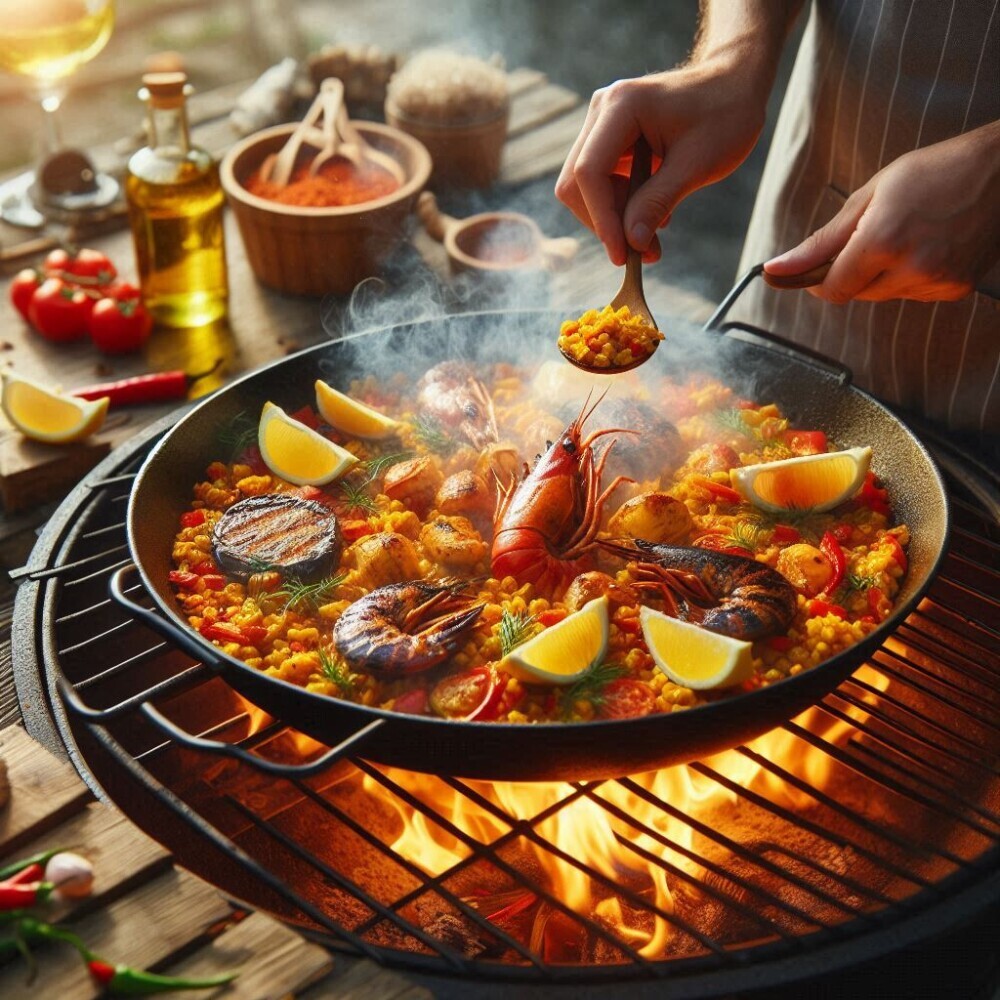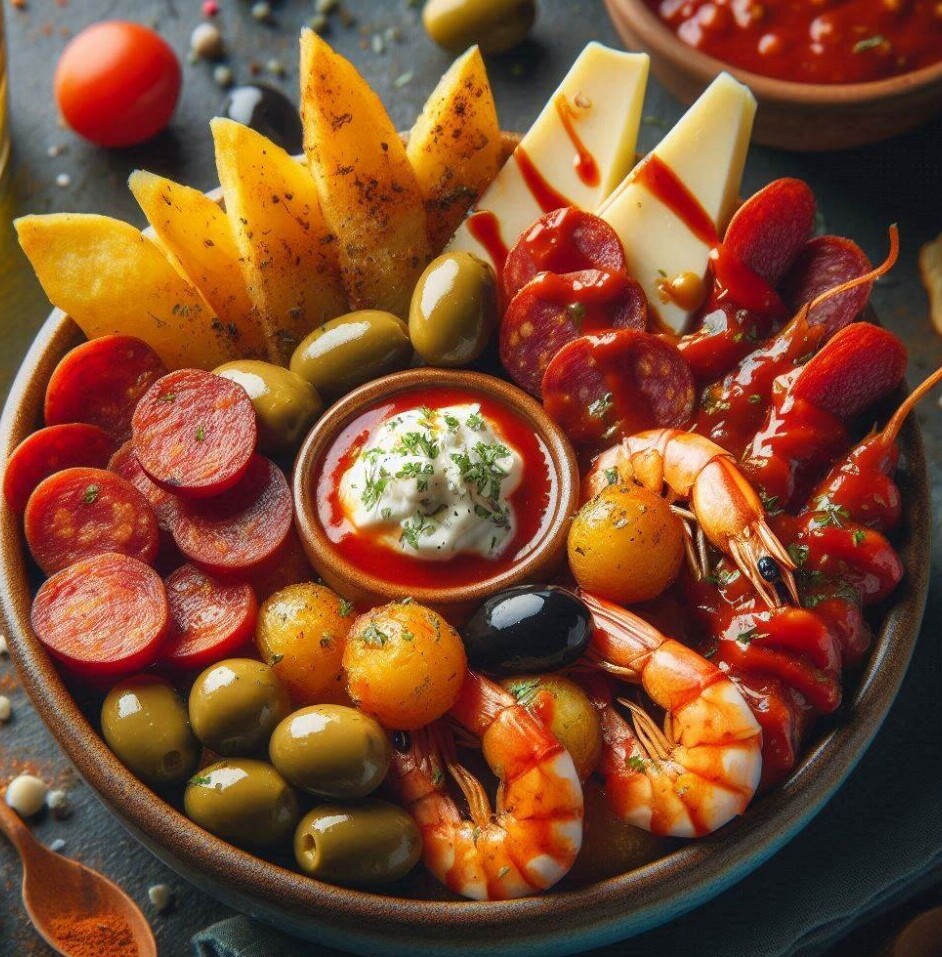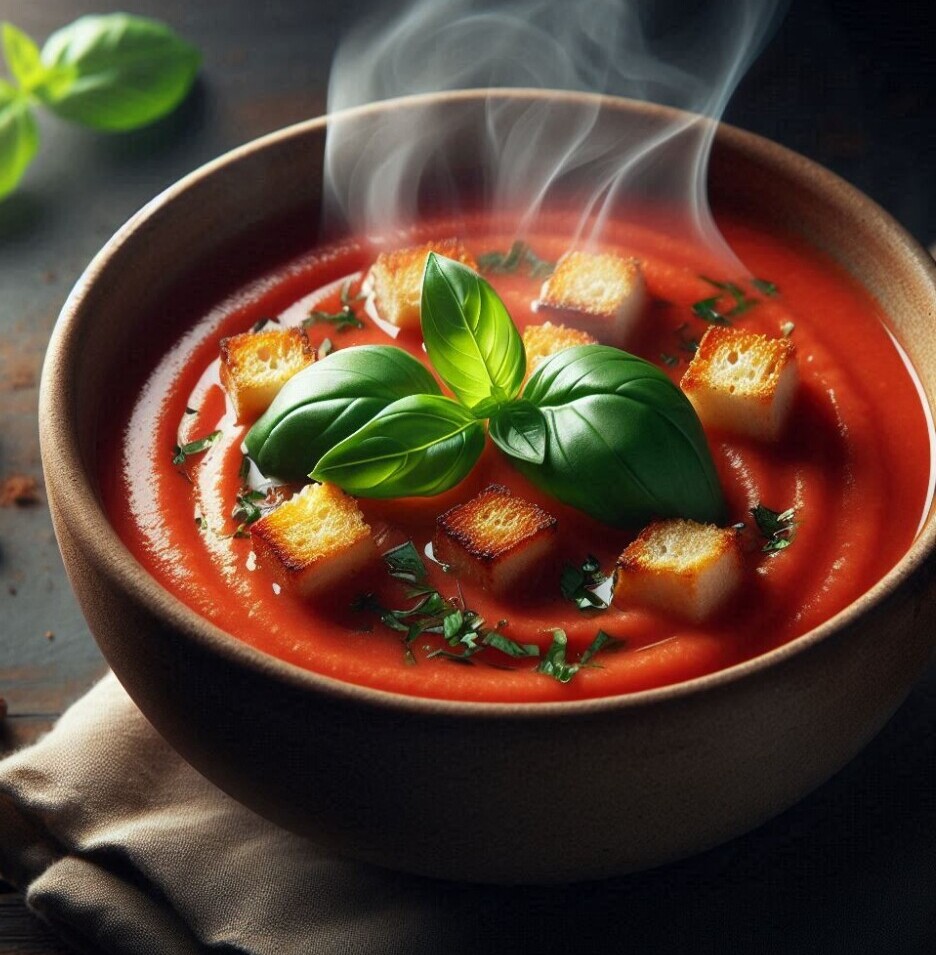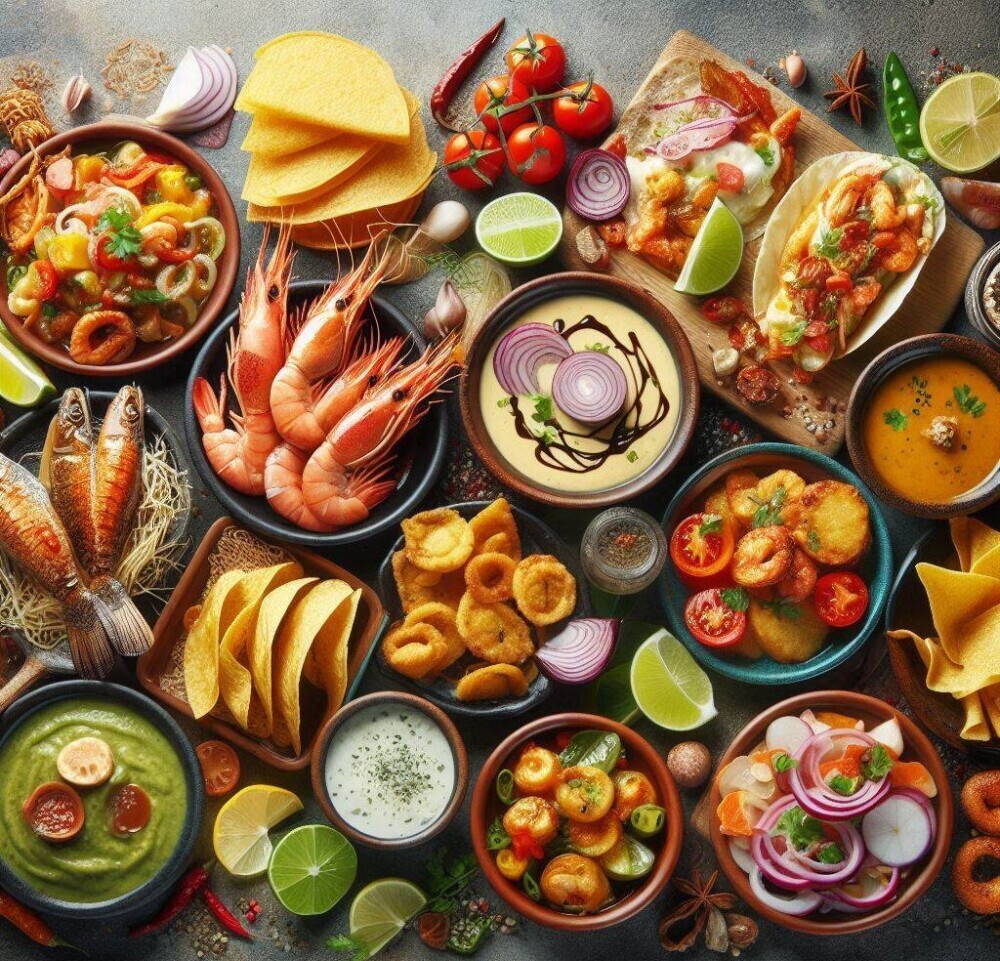My website may contains affiliate links. This means if you click and make a purchase, I may receive a small commission. Don’t worry, there’s no extra cost to you. It’s a simple way you can support our mission to bring you quality content.

Spanish cuisine is a celebration of flavor, tradition, and community. Let’s kick things off with an iconic dish that’s almost synonymous with Spain itself – Paella. Originally from the Valencia region, authentic Paella is a colorful mix of saffron-infused rice, vegetables, and meats like rabbit, chicken, or seafood. Prepared typically in a wide, shallow pan, this dish is shared with friends and family, making it as much about togetherness as taste.
Classic Paella with Rabbit, Chicken, and Seafood
Yields: 4-6 servings Prep time: 30 minutes Cook time: 40-45 minutes
Ingredients:
- 2 cups of either short-grain(bomba rice) or short-grain less starchy rice also known as arborio rice
- 1 cup of chicken broth
- 1 cup of vegetable broth
- 1/2 cup of cooking sherry
- 1/4 teaspoon of saffron threads, soaked in a tablespoon of hot water
- 1 tablespoon of olive oil
- 1 onion chopped into pieces
- 2 cloves of chopped garlic
- 1 green bell pepper diced into pieces
- 1 pound of boneless, skinless chicken thighs, cut into bite-sized pieces
- 1 pound of rabbit, cut into bite-sized pieces – If rabbit meat isn’t available, you can substitute it with either pork or duck meat.
- 1 pound of mixed seafood (shrimp, mussels, clams)
- 1 can of diced tomatoes (14.5 ounces)
- 1 teaspoon smoked paprika
- 1/2 teaspoon salt
- 1/4 teaspoon black pepper
- Lemon(s) cut up into wedges for serving
Instructions:
- Prepare the rice: In a small bowl, combine the saffron-infused water with the chicken broth, vegetable broth, and cooking sherry. Then set it aside.
- Cook the Meat: Warm the olive oil in a large skillet on medium-high heat. Add the onion, garlic, and bell pepper, cooking until they soften roughly 5 minutes. Remove the meat and set it aside.
- Add the seafood: Add the seafood to the skillet and cook until cooked through, about 2-3 minutes. Remove the seafood and set aside.
- Sauté the vegetables: Add the diced tomatoes, smoked paprika, salt, and pepper to the skillet. Cook for 5 minutes, while stirring occasionally.
- Combining ingredients: Return the meats and seafood to the skillet. Stir to combine.
- Add the rice: Pour the rice mixture over the ingredients in the skillet. Distribute the rice evenly.
- Cook the paella: Bring the mixture to a boil. Reduce heat to low, cover, and simmer for 20-25 minutes, or until the rice is tender and the liquid has been absorbed.
- Rest and serve: Remove from heat and let it sit for around 5 minutes. Serve immediately with your lemon wedges.🍴

Enjoy your delicious and flavorful paella!
Note: For a more authentic paella experience, consider using a paella pan and cooking over an outdoor grill or open flame.

Tapas aren’t just snacks; they’re a way of life! These small dishes, which might include olives, chorizo, and Patatas Bravas, offer a perfect excuse for long, leisurely meals. Tapas also vary greatly in size and complexity. Some are simple snacks, while others are more elaborate mini-meals. Tapas culture is all about trying a bit of everything while enjoying good company. They reflect the Spanish approach to dining – relaxed and social.
Here’s a tasty tapas combination for you:
Chorizo and Olive Skewers
- Slice your chorizo chunks into thin rounds about 1/4 inch thick.
- Arrange chorizo slices with olives on skewers.
- Sprinkle with olive oil and place on a platter.
Patatas Bravas
Ingredients:
- 4 large potatoes, peeled and cut into chunks
- Use Olive oil for frying
- 1 cup of marinara or regular tomato sauce
- 1 teaspoon smoked paprika
- 1 teaspoon paprika
- 1 minced garlic clove
- Season with Salt and pepper
- Add Aioli for garnishing
Steps:
- Sauté the potatoes in olive oil until they turn golden brown. Remove them and place them on paper towels to drain.
- In a pan, heat tomato sauce with paprika and garlic, then season with salt and pepper.
- Serve the potatoes dripping with hot tomato sauce and a side of aioli.
Now you’ve got a perfect trio of flavors ready to go! Enjoy.


Next up, we’ve got Gazpacho, a refreshing cold soup made primarily from tomatoes, peppers, and cucumbers. Perfect for warm weather, this blend of fresh veggies and olive oil is a testament to simplicity and pure flavors. It’s like a drinkable salad that speaks to the heart of Andalusian summer. While gazpacho is typically a cold soup, it can also be served warm or even frozen.
Summer Bliss Gazpacho: A Fresh Veggie Delight!
Ingredients:
- Ripe tomatoes
- Cucumber
- Bell pepper
- Red onion
- Garlic
- Olive oil
- Vinegar
- Salt
- Pepper
Instructions:
- Prep vegetables: Roughly chop the tomatoes, cucumber, bell pepper, red onion, and garlic.
- Blend: Combine all chopped vegetables in a blender. Add olive oil, vinegar, salt, and pepper. Blend until smooth.
- Chill: Transfer the mixture to a bowl, cover, and refrigerate for a couple of hours.
- Serve: Stir the chilled mixture and pour into bowls. Drizzle with additional olive oil. Serve cold, optionally with fresh basil or croutons.
- For the warm version of the classic Gazpacho the ingredients are similar to the cold version, but the vegetables are sautéed before blending to add warmth. The blended mixture is then heated on the stove to the desired temperature. It is served warm with a drizzle of olive oil and a side of crusty bread.


Regional variations play a massive role in defining these dishes. For example, with Paella, the ingredients might change based on what’s local and in season. Besides Paella, there are many other dishes that vary significantly from region to region. You might to find more seafood towards the coast and more meats inland.

It’s not just the ingredients; the cooking techniques carry stories of generations. Whether slow-cooked, fried, or simmered, these methods are about getting the most flavor and respecting the ingredients. Spanish cuisine is deeply rooted in tradition, but the creativity and passion of its people make it ever-evolving.
Emerging Trends and Modern Twists in Spanish Gastronomy
Spanish cuisine is constantly evolving, reflecting a blend of tradition and innovation. Global culinary trends have started to infuse new life into classic Spanish dishes, making dining an adventure of discovering unexpected joys in familiar plates.
Renowned chefs in Spain are at the forefront of this culinary evolution. They’ve taken traditional recipes and used cutting-edge techniques to reimagine them. This isn’t just about food—it’s about artistry on a plate.
Ferran Adrià is a renowned Spanish chef and pioneer of molecular gastronomy. His innovative approach to cuisine, exemplified by his former restaurant el Bulli, involves reimagining classic dishes with unique textures and appearances. A prime example is his spherified olive, which looks like an olive but has a surprising texture in the mouth.

Adrià’s influence on contemporary Spanish cuisine is significant and enduring. Chefs like Ferran Adrià help set the stage; inspiring many in the culinary world to explore and redefine what Spanish cuisine can be.
Sustainability is another driving force behind the new wave of Spanish gastronomy. Chefs are focusing on locally sourced, environmentally friendly ingredients. It’s all about creating mouth-watering food that doesn’t cost the earth. This approach not only respects tradition but also paves the way for a deliciously sustainable future in cooking.
A sustainable approach to a Spanish cuisine is created using locally sourced ingredients like arugula, cherry tomatoes, red bell pepper, and Spanish olives. You can add sustainable Spanish tuna and Manchego cheese for added protein and flavor. You can dress this salad with olive oil cooking sherry, and vinegar. Also, season it with salt and pepper. To provide extra crunch add roasted almonds.
This farm-to-table dish is both delicious and environmentally friendly.
As tastes shift, dietary preferences are influencing dish development too. More plant-based options are becoming part of menus. Accommodating a wider array of diners, including vegans and vegetarians. Embracing these preferences doesn’t mean compromising on flavor; it means celebrating the diversity of tastes.
Global culinary trends, technological advancements, shifting consumer preferences, and economic factors, particularly the tourism industry, are collectively driving the evolution of the Spanish Cuisine.
Seems like Spanish chefs are really pushing the boundaries to create even more diverse and innovative dishes. Got a favorite Spanish dish yourself?
